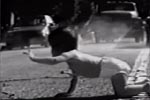 |
Enhancing Instruction with Video: Resources for critical thinking and problem-based learning |
This site showcases several examples of video resources that can be developed to enhance critical thinking and problem-based learning in traditional or distance learning environments.
Depending on the needs of the course, video can be presented to learners in a variety of ways -- VHS tape, CD-ROM, and through the Internet.
You will need Real Player to view these videos. Download Real Player Basic for free.






